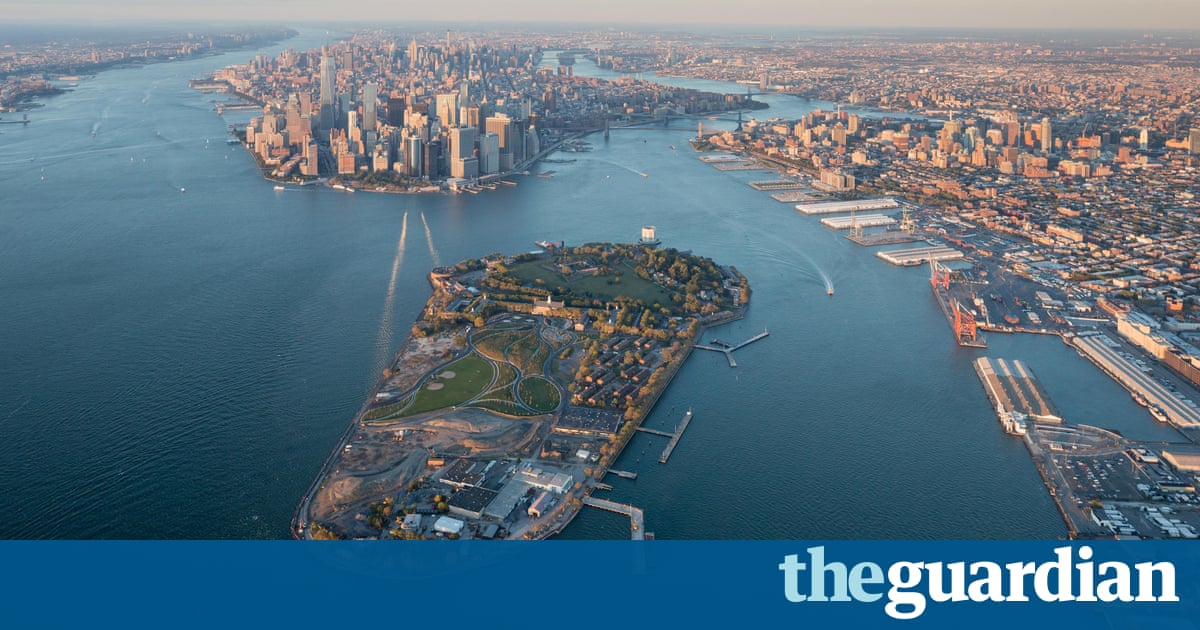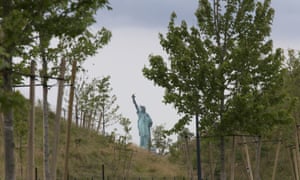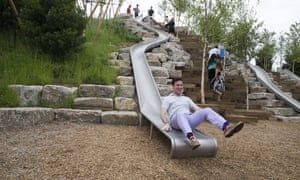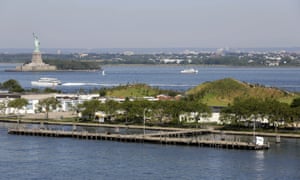Amid rising seas, a park on the island uses Dutch ingenuity to protect itself while maintaining its beauty with barely a seawall to be seen

The Netherlands may have surrendered what is now New York to the English 352 years ago, but if Americas largest city is to withstand the inexorable rise of the seas in the years to come, Dutch ingenuity may well prove crucial.
On Tuesday, a remodelled Governors Island will be unveiled to the public. The 172-acre fragment of land, a seven-minute ferry ride from the southern tip of Manhattan, now has an undulating park covering the southern portion of the island that aims not only to be aesthetically pleasing but also to provide a blueprint for how New York can cope with the ravages of climate change.
West 8, a Rotterdam-based architecture firm, was selected in 2007 to revitalize the area of Governors Island that will now be known as the Hills. While the northern, elevated part of the island has housed a military base and a coast guard, the southern part was rather neglected after being created by dumping landfill material from the Lexington Avenue subway line in 1905. The island is ice cream cone-shaped and the historical part is the ice cream, as Leslie Koch, president of the Governors Island Trust, puts it.

What the Dutch brought to the project was an appreciation of climate change mitigation that was to become almost immediately prescient. Just five months after work started at Governors Island, Hurricane Sandy hit New York in October 2012, causing dozens of deaths in the city as well as a $60bn cleanup bill.
A 13ft wall of water hit us on all sides, said Koch. I live in a neighborhood on elevated ground and cars were crushed by massive trees, so I could only imagine what had happened on Governors Island. I thought wed see a devastated historical district and all that landfill in the New York harbor.
To Kochs surprise, she found the new project was bone dry due to the early decision to raise the previously pancake-flat southern part of the island by 15ft.
The finished Hills area, a selection of four raised areas, the highest peak being 70ft, provides a series of defenses against rising seas and future flood, with barely a seawall to be seen. Indeed, the previous seawall has been broken up and scattered around the hills, supplemented by nearly 3,000 new trees.
A stone shelf juts out from the coast into the sea, covered by large rocks which absorb and dissipate the pounding waves. Should water breach this, a further, subtle barrier is set back from the cycle path that encircles Governors Island (golf carts, rather than cars, are the alternative transport on the island). Finally, the four hills themselves, created from landfill from demolished buildings that dotted the southern part of the island, are arranged in such a way that would sap the strength of even another Sandy.

In a memo created to explain the project, Adriaan Geuze, the West 8 design director, said Sandy had brought the future sooner than we expected, pointing out that the storm surge was a foot above what New York considers to be a once-per-century flood. In the future, weather events that would have once only been expected every 500 or 1,000 years are predicted to become dramatically more common.The Hills has been designed with the assumption that the tide will rise 2ft by 2100.
In order to build a park that is sustainable across the next century, we had to plan for the continuing long-term increase in mean sea level and for the more frequent and violent storms that are expected to accompany climate change along the eastern seaboard, Geuze wrote.
Grass can withstand brackish water, so it was put on the lower levels of the 30-acre park, while other plants were put at higher elevations. The plants themselves were chosen on the basis of their resistance to salt and also future high temperatures many of the varieties are most commonly found in the Carolinas today. West 8 deliberately overpopulated the area with different types of trees so that the strongest, hardiest trees would survive and help knit together the land after a major storm.
Koch, who essentially runs the island, admitted initial skepticism when presented with West 8s plan. While sustainability was a word that the trust was keen on throwing around, mitigating against ruinous storms and surging seas wasnt uppermost in anybodys mind.
I thought: Sheesh, youre Dutch, this is what Dutch people do, they move earth, she said. So I got a crash course in phrases that are now part of everyones vocabulary, such as rising sea level and tides and other phrases the people werent really discussing.

This is really the first park to be really designed as a resilient landscape. And its all integrated with the idea of visitor experience.
The revamped island does offer a bucolic, green oasis in between the no-nonsense glass and steel of Manhattan and Brooklyn. A hiking trail winds up one of the hills leading to a solid concrete hut, an art installation that evokes Henry David Thoreaus yearning to escape to nature.
Of course, this kind of landscaping on a blank canvas of an island cant be replicated everywhere. Lower Manhattan and parts of Brooklyn have billions of dollars worth of infrastructure right beside the water, much of it built on the sort of artificially landfilled areas that were so vulnerable on Governors Island. Molding park land is not the same as protecting shiny real estate, ageing transportation and electrical assets and the people who live amid it all.
Geuze has given it his best shot, however, joining with a group of architects and scientists to propose a string of artificial islands called the Blue Dunes, which would sit about 10 miles from New Yorks coast and ebb the strength of a gathering storm.

The idea hasnt been picked up by city officials, who instead are backing a plan known as the big U a network of flood walls, levees and berms that would loop around lower Manhattan in an attempt to hold back the sea. The cost of this has been estimated at $3bn and rising.
The city certainly faces a stark challenge. Average sea levels have already risen around New York by more than 1ft over the past century, about double the global average. A report put out by the city last year found that a further 21in of seawater could be added by 2050, rising to 6ft by 2100. It could be even more than that if warming temperatures help disintegrate Antarcticas vast ice cap.
Its a situation that New Yorks mayor, Bill de Blasio, has acknowledged is daunting, not least because prime sites such as LaGuardia airport and Battery park in lower Manhattan face looming danger of flooding. Americas financial heart could miss a beat or two if regular inundations cause transportation chaos and businesses abandon the area to those unable to do so. Sea level rise wont stop in 2100, of course one study suggests the coming centuries could see more than 70ft of sea level rise, which would sink all but the upper reaches of Manhattan.

In the shorter term, the example of Governors Island could show the city that simply flinging up large seawalls wont solve the problem. In fact, the walls could just push the water elsewhere, on to the soggy feet of people in Brooklyn or Queens.
A variety of alterations, using natural buffers such as grass and marsh land, could be the unexpected remedy, for now at least. Building design is already starting to adapt, too; parking garages in Rotterdam, for instance, can store excess water, while the Perez Art Museum in Miami has been crafted to withstand hurricanes and floods.
I think its going to be a mixture of things because this is our reality now. Its not an if, its a when, said Koch.
Its not that we have to retreat from the coast but you have to assume the coast will become wet. Look at South Ferry subway station [which was inundated during Sandy]. It opened 10 months before Sandy and its still out of service. Its extraordinary to me that you would build a new piece of infrastructure next to the water and let that happen.
